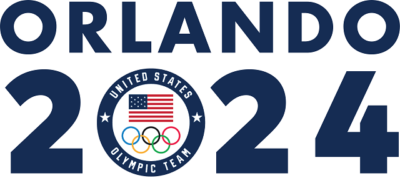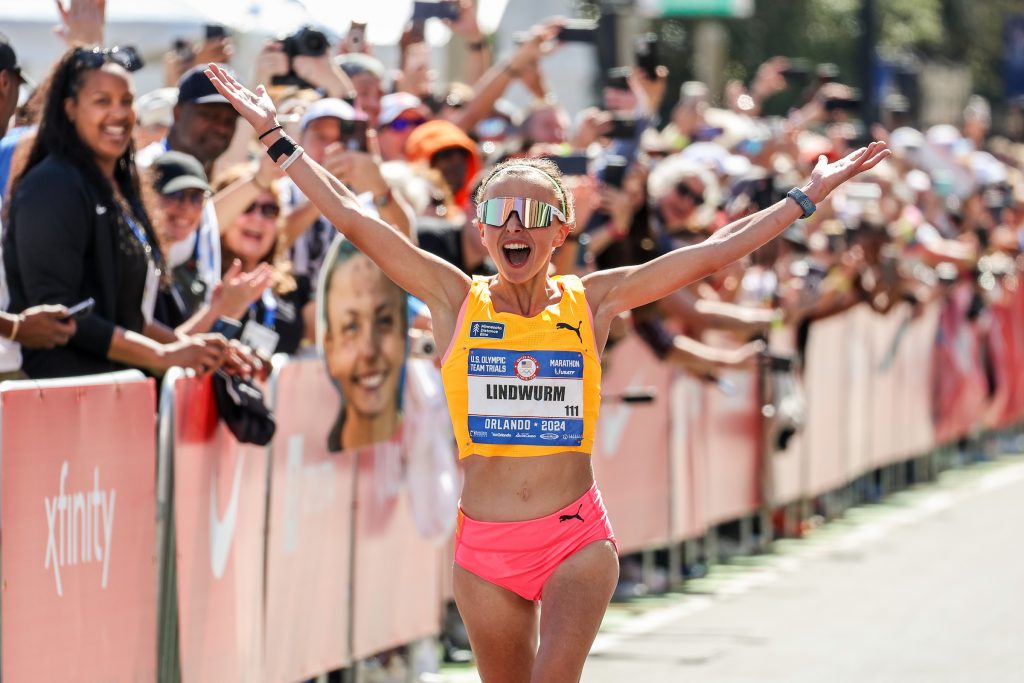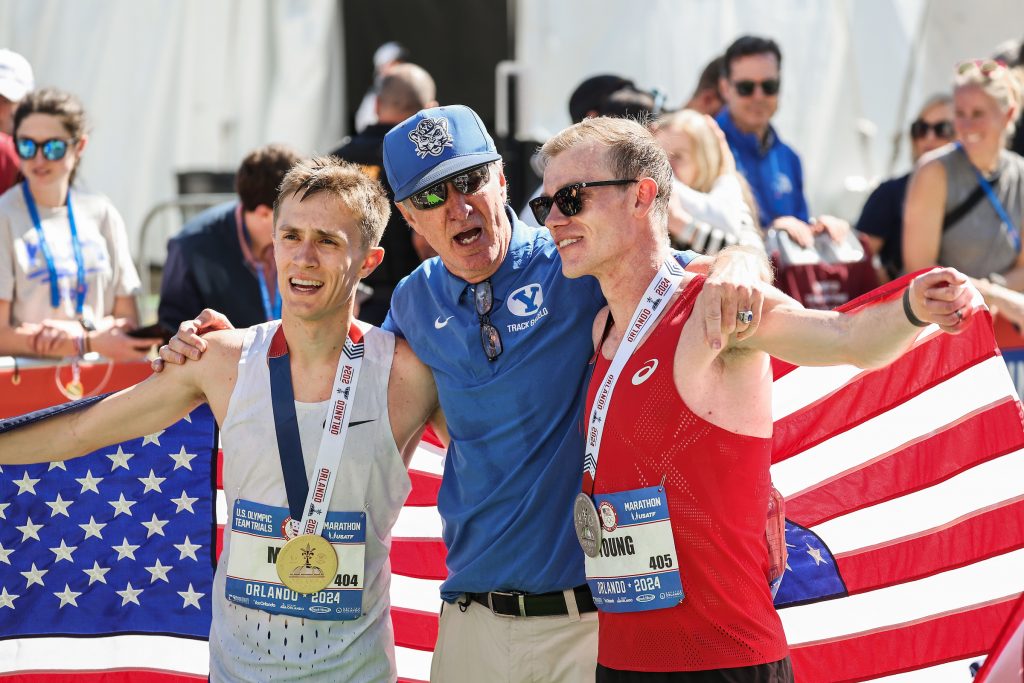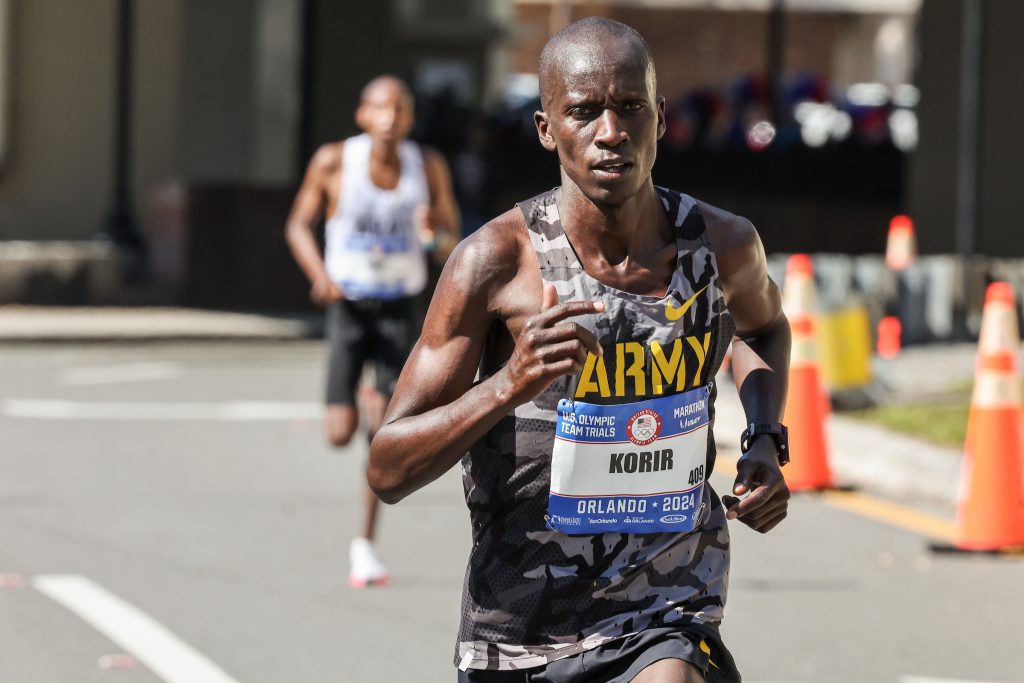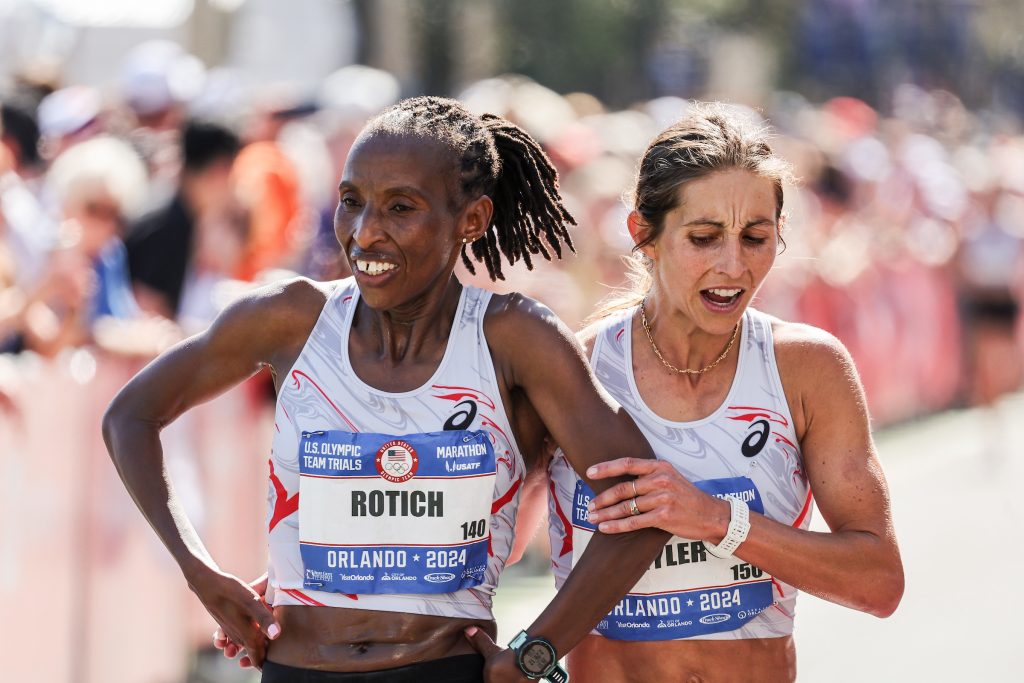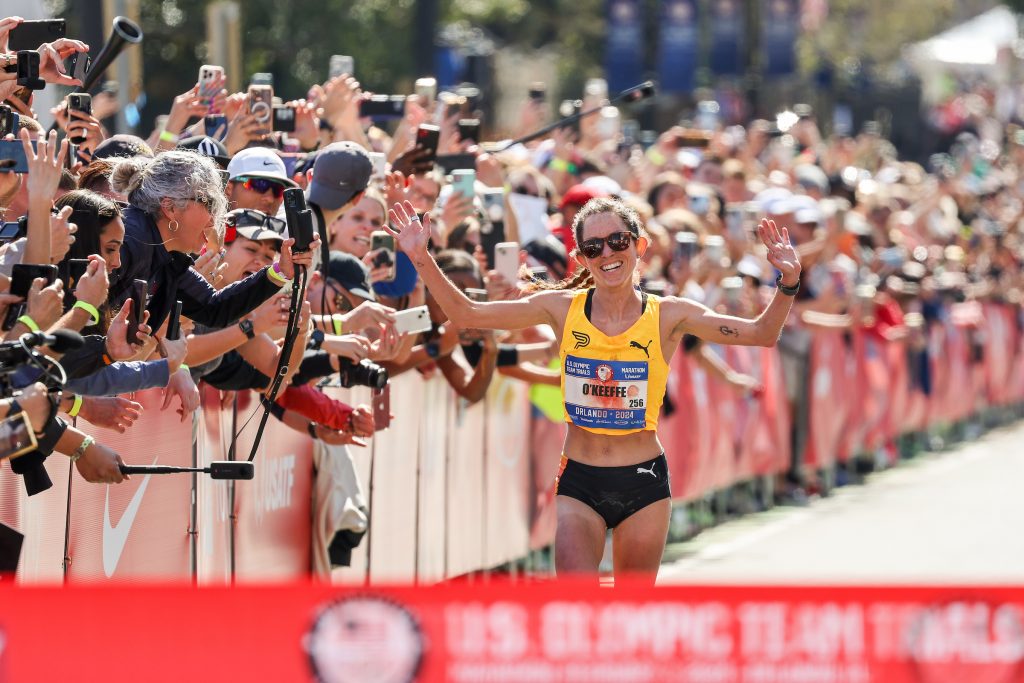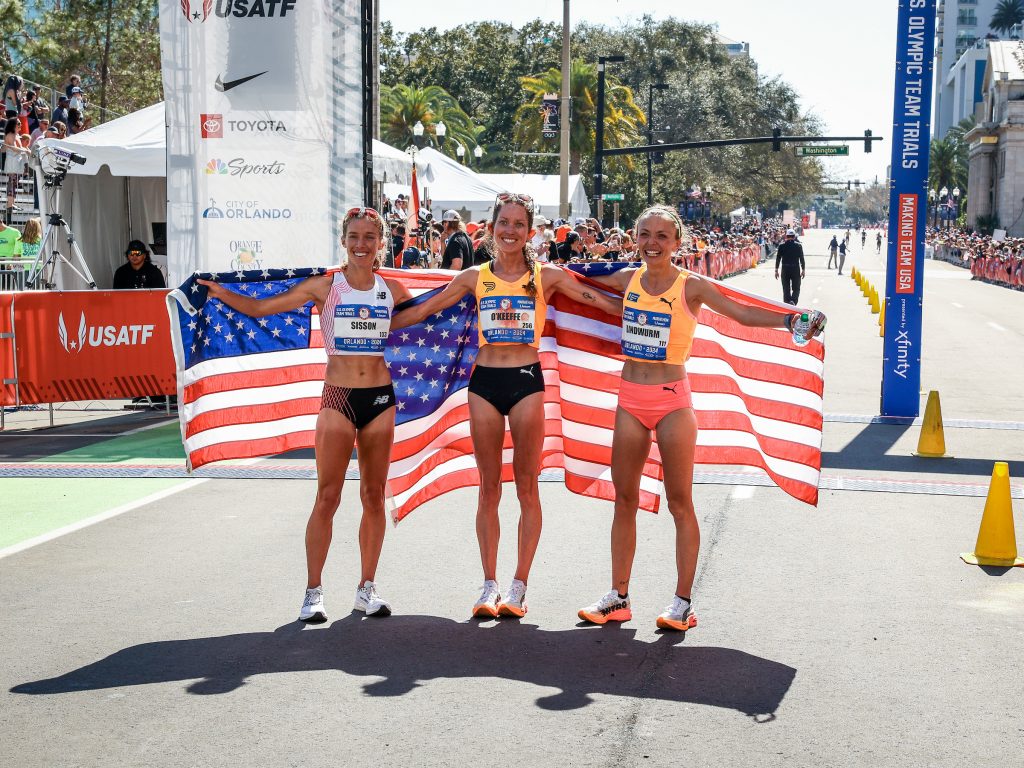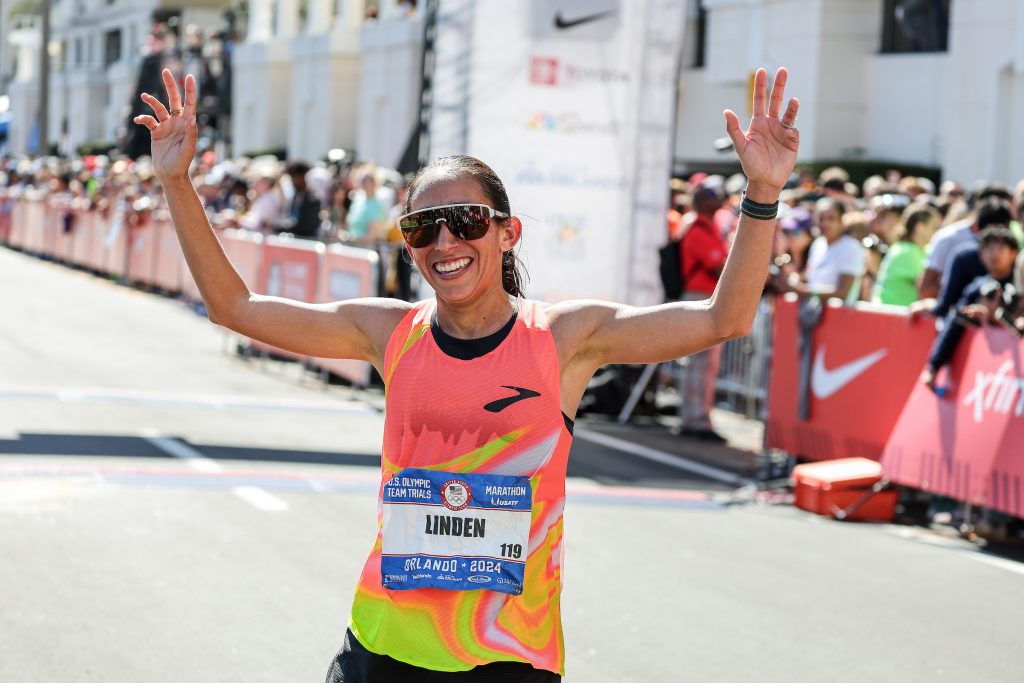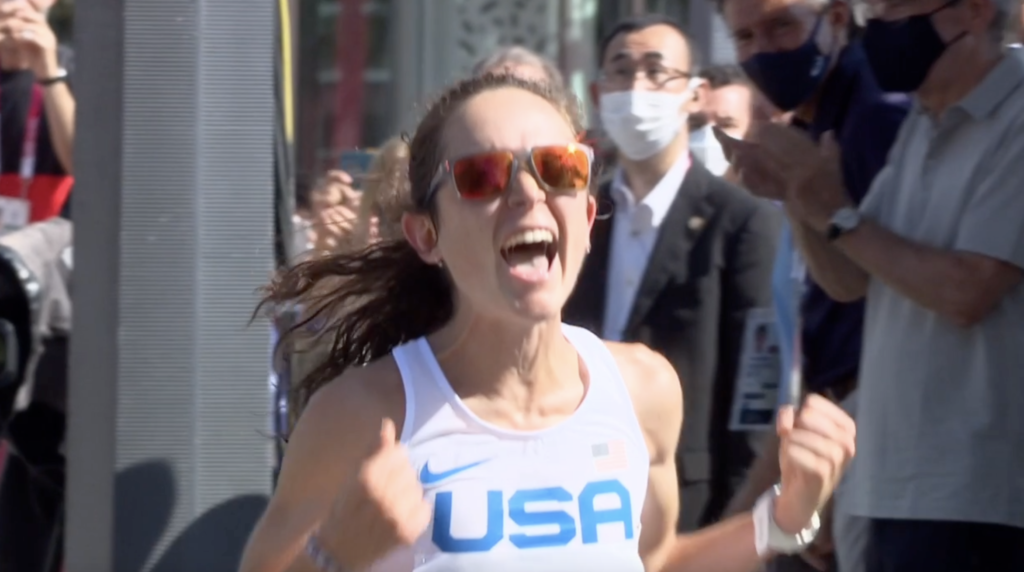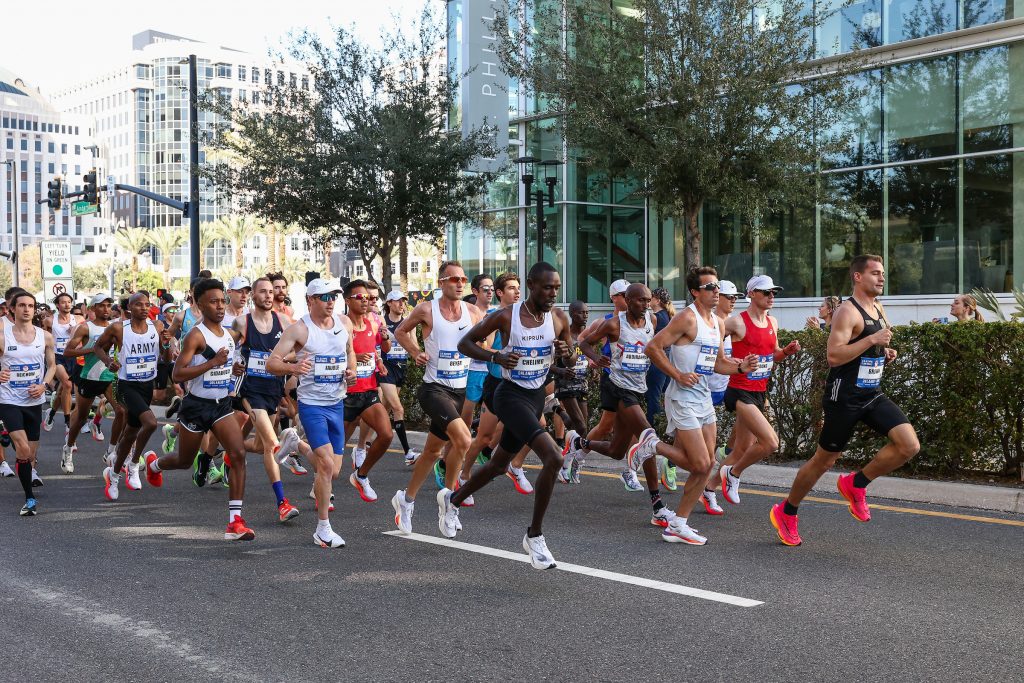20 Final Thoughts on the 2024 US Olympic Marathon Trials
From Dakotah Lindwurm's underdog story to Fiona O'Keeffe's bloody bib to Zach Panning's 2:06 potential, here's one last look at the '24 Trials
By Jonathan GaultThree days have passed since the terrific 2024 US Olympic Marathon Trials in Orlando. We are always looking forward in the sport of running, and there is much to look forward to right now. Fiona O’Keeffe, Emily Sisson, Dakotah Lindwurm, Conner Mantz, and Clayton Young already have one eye on their next marathon at the Olympics. Leonard Korir should bookmark the Road to Paris list. For most of the 346 other athletes who competed on Saturday, their personal Olympic cycles have already reset and they will soon have to decide whether to spend the next four years continuing to chase their dream ahead of the 2028 Olympics in Los Angeles.
But before we move on entirely, it’s worth taking one last look at what unfolded in Orlando on Saturday. The Johnson brothers and I shared many of our immediate reactions in our post-race coverage (men’s recap/analysis, women’s recap/analysis) and in our weekly WTW column (WTW: Zach Panning was super brave (but foolish)), but I’m not done just yet.
Here, in no particular order, are 20 thoughts and observations after spending three days in Florida.
(If you just want results on 1 page with all the DNFs and DNSs, and who PR’d, we’ve got women’s results here and men’s results here thanks to David Monti)
1) How the hell did Dakotah Lindwurm make this team?
Based on her recent results, Lindwurm’s 3rd-place finish was a surprise. At Grandma’s Marathon in June 2023, Lindwurm finished a minute behind the American winner Lauren Hagans. In Chicago just four months ago, Lindwurm only fifth among Americans, behind the likes of Sara Vaughn and Gabi Rooker.
But that’s not the part I cannot understand. Considering two of the top contenders names withdrew before the race (Emma Bates, Molly Seidel), there was a good chance at least one relative long shot would make the team. And while Lindwurm was not a favorite in Orlando, her time of 2:24:40 in Chicago was a pb and gave her the #8 seed time in the field.
No, what still boggles my mind is how Lindwurm got to the point where making the Olympic team was even a possibility. At every point in her running career, she has charged ahead where a less-determined athlete might have quit. In her senior year of cross country at St. Francis High School — where she also played goaltender for the hockey team — Lindwurm (née Bullen) finished 18th at the North Suburban Conference meet and did not even compete at the Minnesota state meet. She graduated in 2013 with pbs of 5:35 for 1600 and 11:56 for 3200. No one would have blamed her if she chose to focus on other things in college.
Instead, Lindwurm walked on at Northern State, a Division II school in South Dakota. She graduated in 2017 with pbs of 5:20 for the mile, 16:43 for 5,000 and 34:57 for 10,000 and a best finish of 6th in the 10,000 at the NCAA DII champs. Again, it would have been easy for her to put aside her competitive running goals. Instead, Lindwurm joined Minnesota Distance Elite, balancing her training alongside a career as a paralegal. By 2022, she had improved enough to run 2:25 in the marathon and earn a professional contract with Puma.
On her Trials bio, Lindwurm lists the following as her favorite motivational quote:
Great moments are born from great opportunity.
It comes from Herb Brooks‘ speech to the US hockey team ahead of their game against the Soviet Union in the movie Miracle. Brooks — like Lindwurm, a Minnesota native — coached the US to a famous victory en route to the gold medal at the 1980 Olympics, one of sports’ greatest underdog stories.
Now Lindwurm is the author of her own Olympic underdog story. Her determination over the past decade earned her the opportunity to compete at the 2024 Trials. She seized the moment and made it great.
2) Is Conner Mantz the successor to Galen Rupp as the next great US marathoner?
When Galen Rupp won the 2016 Olympic Trials, he had seized the torch from Meb Keflezighi as the best American marathoner, and Rupp would hold that torch for much of the next two Olympic cycles. When Mantz beat Rupp in Chicago last fall, it felt like a changing of the guard was in order, and the Trials confirmed it as Mantz won while Rupp hobbled home in 16th.
There are a few caveats here, however. While Mantz was the top American in Chicago and at the Trials, we may actually be in a 1A/1B situation. Remember, Mantz only beat training partner Clayton Young by 13 seconds in Chicago, and they finished together in Orlando, with Young saying he let Mantz take the win. Right now, there is little to separate Mantz and Young, but Mantz, who is three years younger, has the higher ceiling.
The other question is whether Mantz, Young, or anyone from the current generation will ever contend for major marathon victories. For the first two decades of the 21st century, the US always had at least one man capable of contending for the win at World Marathon Majors, whether it was Khalid Khannouchi, Meb Keflezighi, Ryan Hall, or Rupp. But no American man has finished on a WMM podium since Rupp was 2nd in Chicago in October 2021. And in Mantz’s three WMM appearances, he has a best finish of 6th. The gaps from the winner to Mantz: 3:56, 4:31, 7:12.
“If I’m seven minutes off the world record, I need to step up if I want to compete on the international scene,” Mantz said after 2023 Chicago.
3) No one believes in Clayton Young more than his family
Clayton Young’s family made t-shirts for his daughters to wear after the race on Saturday, with a picture of Disneyland Paris on the front and the words “My daddy just made the Olympic team” on the back. Cool idea, but we see this all the time in sports. The NFL, for example, will make commemorative t-shirts for both teams before the Super Bowl, with the losers’ shirts never seeing the light of day.
But one of the craziest things I heard all weekend was when Robert Johnson told me that Young’s mom, Kelly, had bought plane tickets and reserved an Airbnb for the Olympics in Japan ahead of the 2020 Olympic Marathon Trials — the one where Young was injured in his buildup, logged about three weeks of healthy training, and finished 136th overall. Now that is confidence!
4) The men’s finish, and a history lesson
I’ve heard from a number of people who were disappointed about the finish of the men’s race. Why didn’t Mantz and Young race it out to the finish line? There is a national title on the line.
Sorry, I find it hard to get too worked up about this. The main point of the Olympic Trials is to make the Olympic team. If two training partners are so good they can lock up the spots before the finish line, they’ve earned the right to finish how they want. (If they did this at the Olympics, that’s a different story).
Besides, this sort of thing has happened before at the Trials. In 1972, Frank Shorter and Kenny Moore crossed the finish line together and were named co-champions. Farther back in that same race, Jeff Galloway actually allowed Jack Bacheler to beat him for 3rd place because Galloway had already made that year’s Olympic team on the track.
5) CJ Albertson had the interview of the Trials
At some major marathons, athletes have 15-20 minutes to absorb their performance before they are brought to the media area. Not at the Trials. Most athletes cross the finish line and immediately have to walk through the mixed zone after spending the last 2+ hours pushing their bodies to the limit. It can be hard for them to put all of their feelings into thoughts so quickly after crossing the finish line, but the rawness of the emotions can be riveting, and no one showed that better than CJ Albertson, who finished 5th in the men’s race in 2:10:07.
Albertson was 1:13 behind 3rd place at 24 miles but ran miles 25 and 26 in 4:56 and 4:58 and wound up just 10 seconds away from making the team in a pb of 2:10:07. It was equal parts compelling and heartbreaking to watch Albertson process in real time just how close he came to making the team. He finished by vowing he’ll be back in 2028.
“My kids aren’t old enough to understand [the Olympics], so I’ll make it when I’m 34,” Albertson said.
6) The mystery of Fiona O’Keeffe’s bib stain
When Fiona O’Keeffe broke the tape to win the women’s race on Saturday, many observers wondered about the large red splotch on her bib.
Thanks to Race Results Weekly’s David Monti, we have an answer: O’Keeffe had stored a gel in her sports bra, and during the race it chafed against her chest and caused her to bleed. The blood soaked through her sports bra and singlet and onto the bib. (LetsRun confirmed this with O’Keeffe’s agent). If anything, the blood only makes O’Keeffe’s win more iconic, like Curt Schilling‘s famous sock during the 2004 American League Championship Series.
7) What happened to Scott Simmons’ guys running 2:08:10?
When I spoke to coach Scott Simmons the week before the Trials, he told me his American Distance Project/Army WCAP athletes — Paul Chelimo, Leonard Korir, Shadrack Kipchirchir, and Sam Chelanga — would try to run 2:08:10 in Orlando, even if conditions were warm.
“That’s the only strategy for any of the four guys we have to make the team,” Simmons said. “…There’s only two ways to make this team. Run under 2:08:10 and finish top 3. Or 2:11:30 and shoot for 1st or 2nd. But I don’t think [the second one] is a good strategy.”
But before Zach Panning picked things up during mile six, the men’s leaders were on just 2:11:31 pace through five miles and none of Simmons’ guys showed the slightest inclination toward trying to run 2:08. Was the 2:08 talk just a little pre-race gamesmanship? Did Simmons’ group change their plans? Were they planning on taking off and Panning beat them to the punch?
8) 2024 was the third straight Trials in which an athlete made the Olympic team in their marathon debut
Galen Rupp did it in 2016, Molly Seidel did it in 2020, and Fiona O’Keeffe did it in 2024.
It was also the fourth straight Trials in which an African-born man made the team. Abdi Abdirahman (born in Somalia) and Meb Keflezighi (born in Eritrea) did it in 2012, Meb made the team again in 2016, Abdi made the team again in 2020, and Leonard Korir (born in Kenya) made it in 2024.
9) The final miles were way more exciting than your typical major marathon
One of the things that makes the Olympic Trials great is that the top three spots are all important.
Most major marathons these days tend to fall into one of two categories. Either the eventual winner breaks away and runs unchallenged to the finish or there is a group of athletes together until the final mile or two and they try to outsprint each other to the finish.
The men’s race in Orlando offered a third scenario, which I find more exciting than the other two: a bunch of runners spread out, moving at different speeds. Some are spent and just trying to hold on (Zach Panning). Some are full of run and making a late charge (CJ Albertson). Some are both (Leonard Korir). It made for an incredibly dramatic finish: three different men occupied the third Olympic spot over the last 1.2 miles. It was similar in Atlanta four years ago where five men occupied the final two Olympic spots over the final 10k.
This sort of thing happens in major marathons too, but no one is truly invested for the battle for 3rd in those races. Other than a few thousand dollars in prize money, there’s not a huge difference between finishing 3rd and 4th in Boston. There is an enormous difference between finishing 3rd and 4th at the Trials. And that creates more opportunity for drama in the final miles as there are more players in the mix.
Thanks to Panning’s aggressive pace and the rising temperature in Orlando, many athletes wound up hitting “The Wall” late in the race, which we used to see more frequently before super shoes began saving everyone’s legs. That led to carnage in the final miles.
Just look at the splits below for the top six over the final six miles, along with the place they were in at the time.
| Athlete | Mile 21 | Mile 22 | Mile 23 | Mile 24 | Mile 25 | Mile 26 | Final 0.219 |
| Conner Mantz | 4:59 (2nd) | 5:07 (1st) | 5:06 (2nd) | 5:09 (2nd) | 5:03 (2nd) | 5:15 (2nd) | 1:04 (1st) |
| Clayton Young | 4:58 (3rd) | 5:07 (3rd) | 5:06 (3rd) | 5:09 (1st) | 5:03 (1st) | 5:15 (1st) | 1:05 (2nd) |
| Leonard Korir | 5:06 (4th) | 5:17 (4th) | 5:19 (5th) | 5:25 (5th) | 5:09 (5th) | 5:08 (3rd) | 1:02 (3rd) |
| Elkanah Kibet | 5:15 (5th) | 5:11 (5th) | 5:08 (4th) | 5:14 (4th) | 5:07 (4th) | 5:23 (4th) | 1:06 (4th) |
| CJ Albertson | 5:12 (9th) | 5:05 (8th) | 5:06 (7th) | 5:09 (6th) | 4:56 (6th) | 4:58 (5th) | 0:58 (5th) |
| Zach Panning | 4:59 (1st) | 5:07 (2nd) | 5:06 (1st) | 5:28 (3rd) | 5:28 (3rd) | 6:03 (6th) | 1:17 (6th) |
(Note: Mile 25 is about 33 feet downhill)
It’s incredible to read. Panning had 38 seconds on 3rd at 23 miles but all it took was two 5:28s and a 6:03 for all his hard work to evaporate. And what about Korir? After slowing down and dropping 5:19 and 5:25 miles back to back, he was 37 seconds back of 3rd at 24 miles. Who would have picked him to make the team then? Somehow he rallied and erased a 15-second gap to Kibet over the final 1.2 miles.
Here’s the same table for the women.
| Athlete | Mile 21 | Mile 22 | Mile 23 | Mile 24 | Mile 25 | Mile 26 | Final 0.219 |
| Fiona O’Keeffe | 5:26 (1st) | 5:26 (1st) | 5:20 (1st) | 5:23 (1st) | 5:09 (1st) | 5:21 (1st) | 1:08 (1st) |
| Emily Sisson | 5:32 (2nd) | 5:32 (2nd) | 5:29 (2nd) | 5:32 (2nd) | 5:09 (2nd) | 5:15 (2nd) | 1:06 (2nd) |
| Dakotah Lindwurm | 5:38 (4th) | 5:40 (3rd) | 5:45 (3rd) | 5:53 (3rd) | 5:43 (3rd) | 6:05 (3rd) | 1:19 (3rd) |
| Jessica McClain | 5:42 (10th) | 5:43 (8th) | 5:40 (8th) | 5:45 (8th) | 5:34 (6th) | 5:41 (4th) | 1:08 (4th) |
| Sara Hall | 5:48 (7th) | 5:47 (5th) | 5:51 (5th) | 6:06 (5th) | 5:49 (5th) | 6:12 (6th) | 1:13 (5th) |
| Caroline Rotich | 5:35 (3rd) | 5:42 (4th) | 5:45 (4th) | 5:53 (4th) | 5:56 (4th) | 6:31 (5th) | 1:21 (6th) |
Lindwurm ran her 19th mile in 5:30 and her 20th in 5:34, which means that aside from the downhill 25th mile, her final eight miles were each slower than the one before it. Normally you do not make an Olympic team by running mile 26 in 6:05 (2:39 marathon pace), but it didn’t matter because everyone was hurting at that point — three of the top six women ran mile 26 slower than 6:00.
Meanwhile, Jessica McClain went from 59 seconds away from making the team at 24 miles to just 15 seconds away by the finish — even though her 26th mile was only 5:41 (2:29 pace).
All of this leads me to my next point…
10) If the goal was to select the best Olympic marathon team, the weather on Sunday was almost ideal
After Orlando was selected as host, there was a large outcry to move the start time forward to ensure the race was not held in dangerously hot conditions. And while the median temperature at 2 p.m. in Orlando from 2012-22 was 73 degrees, there were a couple of 80+ degree days during that span. If you go much beyond 80, you’re entering unsafe conditions for a marathon.
So the concern was not unfounded. But as it happened, the actual race-day conditions — temps around 60 at the start climbing to the low-70s by the finish — were near-perfect for selecting an Olympic marathon team. The Olympic marathons will be on August 10 and 11. It is going to be warm. The athletes who made the team on Saturday showed they are able to manage the heat — a skill that will be necessary for success in Paris.
11) Where did Caroline Rotich come from?
When did you realize 2015 Boston Marathon champion Caroline Rotich was running the Olympic Trials? For me, it was not until the second half of the race on Saturday, when NBC Sports’ Nick Zaccardi pointed it out in the media center. The 39-year-old Rotich was neck-and-neck with Dakotah Lindwurm for the final Olympic spot as late as 24 miles and wound up 6th in 2:26:10.
You could be excused for overlooking her. The Kenyan-born Rotich only became a US citizen in March and only became eligible to represent the US in October. She never appeared on USATF’s list of qualifiers, and though she was among the official entries, her seed time was listed as just 2:30:59, which she ran at the 2022 NYC Marathon.
Rotich has been based in the US since 2009, largely in Santa Fe, N.M., but now in Colorado Springs. Throughout that time, she had been coached by Ryan Bolton — a 2000 US Olympian in the triathlon who also coaches runner-turned-Olympic-triathlete Morgan Pearson. At the end of 2022, Rotich moved into what Bolton describes as semi-retirement and while the two remained close, Bolton stopped coaching her.
“She was like, I’m going to run a couple races here and there on occasion,” Bolton said. “We’ll just kind of see.”
Rotich’s results in 2023 were not impressive at all — she only ran 2:46 at the Toronto Marathon on October 15. But Rotich’s transfer of allegiance from Kenya to the US had been approved earlier that month, and she was determined to run the US Olympic Trials. She wanted a serious coach again and reached out to Bolton at the end of October. Within a week, he had drawn up a training schedule and Rotich had boarded a flight to Kenya, where she would train for the Trials in Iten.
Though Rotich is obviously talented, she was starting from a low place. For one of Rotich’s first Trials workouts, on November 14, he assigned her a 13-mile progression run, asking her to run the first half at 7:00 pace and the second half just under 6:00 pace. Rotich averaged 7:20 for the first half and 7:00 for the second. On November 29, Rotich ran a broken tempo, with five miles at 6:05 pace, a mile jog, then three miles at 6:00 pace. Just nine weeks later, she averaged 5:34 pace for an entire marathon.
“Her numbers really weren’t starting to look competitive until the last, maybe three or four weeks,” Bolton said. “You see stuff, even on you guys LetsRun, of some of these girls in December just ripping these crazy workouts. And I’m like, oh my gosh, Caro can’t run a 6:00 mile right now.”
For more on Rotich and Bolton, check out this 2015 LRC profile: From Santa Fe To Boylston Street: How American Coach Ryan Bolton, An Olympic Triathlete, Helped Caroline Rotich Win The 2015 Boston Marathon
12) The crowd in Orlando was unreal
LetsRun’s Robert Johnson was on the men’s lead truck and was super impressed by the energy and noise coming from the crowd in Orlando. Leonard Korir credited the fans for helping him to rally in the final miles and said he liked the criterium-style course that allowed fans to see the runners multiple times. He compared the energy to an NBA Finals game.
“When [the fans] were screaming and cheering, I got some extra energy,” Korir said. “It was like a superpower of track & field…It’s so amazing. Thank you to the organization who made the course this way. I wish they had more races like this one. That was the turning point for [me] to finish 3rd.”
The one problem is that NBC’s audio levels were not adjusted properly for parts of the race, which meant that the crowd would occasionally drown out Kara Goucher while she was making a point.
13) Some rapid-fire thoughts on the broadcast
I rewatched the NBC broadcast on Sunday morning. A few thoughts:
- Overall, Leigh Diffey and Kara Goucher did a good job. Clearly they did their homework by visiting LetsRun.com as they used a few nuggets from our pre-race coverage, including Goucher noting that while Mantz may beat Young in workouts, Young may have the edge when it comes to recovery or sauna sessions. A shoutout would have been nice, but we’re glad they are reading LetsRun.com.
- The standings with the gaps between athletes and tracking of notable athletes was a hit during the 2020 Trials and NBC was wise to bring it back in 2024. Kudos as well to Diffey and the production team on keeping viewers informed when prominent athletes were dropping back or dropping out. The Betsy Saina DNF was a huge moment in the race and NBC did well to capture it.
- Anyone else find it strange how the broadcast felt like a paid Orlando tourism commercial? Obviously the Greater Orlando Sports Commission paid a bunch of money to host the Trials in order to promote their city and want some return on their investment. But it was pretty strange for Diffey and NBC to spend the first 30 seconds coming out of almost every commercial break talking about Universal Studios or the benefits of Orlando’s central business district.
- I wish the battle for 3rd between Kibet and Korir was covered better in the men’s race. NBC did a good job of using multiple cameras to track each race as the breaks happened, but Korir’s comeback over the final 1.2 miles was incredible and we barely saw any of it.
- Why were Mantz, Young, and Korir being interviewed on-screen when there were only two miles to go in the women’s race? The interview lasted four minutes before NBC finally introduced a split screen. Add in the commercial break before the interview, and we missed almost seven minutes of the women’s race during miles 24 and 25. The fix is simple: interview the top men right after they finish but don’t show it until the women’s race is over. (Editor’s note: Or hold the Trials races at different times. If both Trials races go to the same city in 2028, we’d love to see one sex run on Saturday and one run on Sunday. We’ve long said it’s near impossible to broadcast two sporting events properly at the same time on the same channel).
14) Zach Panning is going to run a fast marathon somewhere soon
For the 15-mile stretch from 5 miles to 20 miles, Panning averaged 2:06:17 marathon pace in warm, sunny conditions without a pacemaker. He’s been running workouts a 2:06 guy would be proud of. Can we get him in Valencia this year and see what he does in perfect conditions?
15) Could the US women sneak an Olympic medal in Paris?
Three years ago, in one of our LetsRun Supporters Club podcasts during the Tokyo Olympics, I threw out the possibility that Molly Seidel could medal in the Olympic marathon. It wasn’t a prediction, and I was working on about five hours’ sleep, but my logic was that because of the heat, weird things can happen in an Olympic marathon. Someone like Seidel would have no chance in a race like last year’s Chicago Marathon, where it took 2:17 to reach the podium. But in the Olympics, it’s all about surviving the conditions. Seidel ran 2:27 in Sapporo, and that was enough for the bronze.
Between world record holder Tigist Assefa, Boston/NYC champ Hellen Obiri, and perhaps London/Chicago champ Sifan Hassan, the competition is going to be brutal in Paris. But I wouldn’t write off a US medal. Fiona O’Keeffe just ran 2:22 in her debut in warm conditions similar to what she will face in Paris. Plus her coaches Alistair and Amy Cragg say she thrives on hills, and there are some monster hills in the middle of the Olympic course. She has a shot.
Emily Sisson might have a chance too. She’s a good heat runner and I’m not concerned that she did not win the Trials — Meb, Seidel, and Deena Kastor didn’t win the Trials when they medalled either. The problem for Sisson is the hilly course, which does not play to her strengths.
16) Des Linden’s longevity
The 40-year-old Linden was not close to making her third Olympic team on Saturday, but she did manage her fifth straight top-15 finish in Orlando. Check out her career results at the Trials:
2008 Boston: 13th, 2:37:50
2012 Houston: 2nd, 2:25:55
2016 Los Angeles: 2nd, 2:28:53
2020 Atlanta: 4th, 2:29:03
2024 Orlando: 11th, 2:28:04
Incredibly, no woman finished in the top 10 in both 2020 and 2024. Linden, 4th in Atlanta and 11th in Orlando, came the closest. For the men, Korir (4th 2020, 3rd 2024), Albertson (7th 2020, 5th 2024), and Colin Bennie (9th 2020, 10th 2024) finished top-10 both years.
17) It was a big day for BYU & Stanford
Of the top 20 finishers in the men’s race in Orlando, no school was represented more than once apart from BYU, who had alums finish 1st (Mantz), 2nd (Young), and 12th (Connor Weaver). If you’re curious about the breakdown, 16 of the top 20 ran at an NCAA Division I school. DII, DIII, and NAIA schools each had one top-20 finisher while Daniel Mesfun (15th), who came to the US from Eritrea, did not run in college.
It was similar on the women’s side as only one school had more than one top-20 finisher — Stanford, who had alums take 1st (O’Keeffe), 4th (Jessica McClain), and 5th (Sara Hall). Of the top 20, 16 ran at DI schools, one ran DII, one ran DIII, one did DIII gymnastics (Gabi Rooker), and one did not run at a US college (Caroline Rotich).
18) Timing is everything with the Olympic Trials
“Olympian” is one of the most coveted titles in our sport, and for most athletes, making an Olympic team is a lifelong dream. But because an Olympics comes around once every four years, most athletes only get one or two shots to make a team in their prime. That means timing plays a huge role in who gets to call themselves an Olympian.
Think about Donavan Brazier. He’s made two world teams and was the 2019 world champion. He was on fire in 2020 when the Olympics were postponed but was hurt in 2021 and has never made an Olympic team. Chris Solinsky made two world teams and had an incredible 2010 season where he ran 26:59 and broke 13:00 three times. He never made an Olympics either.
It works the other way, too. 2020 Olympian Jake Riley had a one-year stretch in his career when he was an elite marathoner and it happened to coincide with an Olympic Trials. In February 2023, Clayton Young was far off the Olympic radar and was about to undergo knee surgery. One year later, he’s on the team to Paris.
Emma Bates and Molly Seidel, both sidelined from the Trials, must have watched Lindwurm make the team on Saturday and thought, If only I was healthy, that could have been me.
This all reminds me of one of my favorite scenes from How I Met Your Mother. To paraphrase Robin Scherbatsky, all you need to make an Olympic team is talent, hard work, and timing. But timing’s a bitch.
19) A response to Amby Burfoot
In case you missed it, former Runner’s World editor-in-chief and 1968 Boston Marathon champion Amby Burfoot has written a column calling for USATF to pick the Olympic marathon team via a selection panel instead of a trials race. I have a lot of respect for Amby, and this column does not change that, but he’s totally off-base here.
Amby loves the excitement and drama of the Marathon Trials, even calling it his “favorite distance event by far,” and that is one of the primary reasons the Trials needs to stick around: it is America’s greatest marathon. The sport needs more events that matter, not fewer.
But Amby’s main point is that USATF could pick a better Olympic team than by going off the results of the Trials.
I disagree.
A selection committee would not have picked Jared Ward for the 2016 Olympic team, but he made the team and finished 6th in Rio. A selection committee would not have picked Molly Seidel in 2020, and she wound up earning Olympic bronze in Sapporo. A selection committee would not have picked Fiona O’Keeffe before she ran 2:22:10 in Orlando on Saturday.
There are few instances in which there are three clear-cut Olympic candidates, which means any team chosen by committee would invite controversy. A Trials race is not a perfect solution, but it produces the fewest complaints about fairness and it’s entertaining as hell. It’s like that old Churchill quote about democracy — a Trials is the worst way to pick the team except for all those other ways that have been tried from time to time.
MB: Amby Burfoot says: do away with the Olympic Marathon Trials
20) Was this the last Olympic Trials?
Just before the race began on Saturday, I was chatting with Sarah Lorge Butler of Runner’s World, who asked me whether I thought there would be an Olympic Marathon Trials in 2028. It’s an interesting question.
The Olympic Marathon Trials have been around since 1968 for the men and 1984 for the women, with the two events finally merging in 2012 (until then, they were held at separate sites on separate days). It would be a tremendous loss for the US running community if the Trials were to disappear.
But they are also expensive to stage. Host cities must pay for prize money ($600,000 this year), athlete travel and lodging, promotion, as well as a bunch of race operations expenses. Oh yes, and they must pay a $100,000 fee to USATF just for the right to host the Trials. All of that adds up: when Houston hosted in 2012, it spent a total of $2.3 million on the event.
It’s also hard to make that money back. USATF and USOPC control many of the revenue sources and it’s much harder to sell tickets for a road race than a track meet. The New York Road Runners lost over $1 million hosting the men’s Trials in 2007, Houston lost $400,000 in 2012, and Atlanta Track Club CEO Rich Kenah said Atlanta lost money on the 2020 Trials and would not bid again “unless there is a significant change in the bid requirements.”
USATF had two bidders for the 2024 Trials, Chattanooga and Orlando. Chattanooga left with a sour taste in its mouth after USATF CEO Max Siegel overruled the USATF Board’s unanimous recommendation to award the Trials to Chattanooga. Instead, Siegel DQ’d Chattanooga’s bid due to a questionable conflict of interest ruling and handed the Trials to Orlando.
It hasn’t been all smooth sailing with the Orlando organizers, either. USATF threw the Orlando local organizing committee (LOC) under the bus for refusing to change the start time of the race, after which the LOC responded by shifting the blame back onto USATF.
And then there are the races themselves. The big appeal of an Olympic Trials is that is easy for the average fan to understand: top three finishers make it to the Olympics. But World Athletics introduced tougher qualifying standards for 2024 which made things more complicated, and considering 63 athletes (out of a target field of 80) have already hit the auto standard, those standards are likely to get even tougher in 2028, which could further complicate the Olympic Trials. Will cities still want to host an event that might only select one or two Olympians instead of the full team?
My guess is that there will still be a Trials in 2028. The way USATF treated Chattanooga and Orlando may scare off some bidders, but it only takes one midsize city looking to raise its profile to host the Trials. And considering these Trials would be selecting a team for a home Olympics in 2028, there may be even more interest than usual.
But I wouldn’t be shocked if we’re in the same place four years from now and I’m writing this same article wondering if 2028 Trials was the last one.
Editor’s note from LetsRun co-founder Robert Johnson: Amazing article but the last point is depressing. Admittedly, if the US doesn’t have three spots, the Trials lose their luster but 1) $2.3 million is nothing for a city. And if a city doesn’t want to pay it, it shouldn’t be hard for USATF to come up with $2.3 million over four years. In fact, I KNOW how they could easily save $600k per year. And here’s an idea to come up with some revenue since it’s hard to charge spectators: charge $5 to use the timing app.
More from 2022: LRC Are the US Olympic Marathon Trials Broken? Examining the Business Model of America’s Greatest Marathon
Talk about this article on our world-famous fan forum / messageboard:
- MB: Great read: Jonathan Gault’s 20 Final Thoughts on the 2024 US Olympic Marathon Trials
- MB: Amby Burfoot says: do away with the Olympic Marathon Trials
More: WTW: Zach Panning was super brave (but foolish), Femke Bol & Noah Lyles love to compete, and how fast is BU? Last week, Zach Panning put on a performance that would have made Steve Prefontaine and Sammy Wanjiru smile, Noah Lyles and Femke Bol returned the sport they love in a big way and we found out how much faster the BU track is than other tracks.
*Complete 2024 US Olympic Marathon Trails Coverage
